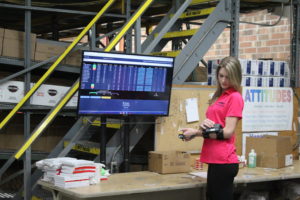When I say real-time operational floor dashboards, what do you think of? Does your brain immediately go to “where would I put the monitors?” or do you think “what would I show on them, and how would they be updated?” Maybe you think, “what would they help with?” Do you also think “how much could they improve productivity?” Probably not, but guess what? The use of monitors on the warehouse floor that display picker and stocker stats can dramatically change the game for your company – if you have the right metrics, update frequency, and user interface (along with harmonized incentives) to engage the workforce.
The Power of Floor Dashboards & Monitors
Let’s start by addressing these questions.
Where would I put the monitors?
It’s understandable why your mind might jump to this question. You want your warehouse optimized for storage and productivity. We generally find that break-rooms and around punch-clocks are the most logical places for floor dashboards. But your organization may have other areas. All you need is power and WiFi–so don’t be limited by places where computers are located or where supervisors sit.
We encourage you to make this data accessible to everyone. The key is to put them in frequently accessed areas or at key points of work direction and assignments. Don’t make them hard to see–employees will quickly come to enjoy them, rely on them, and reference them on a regular basis!
What would I show on them and how would the data be updated?
This is a critical question, and it’s important to get the answer right. For warehouse-based operations, it’s often a picker dashboard–stack-ranking employees in real-time by productivity. It can also show time between picks, number of orders completed or similar information, based on your business.
The key is to show information that encourages individual performance. And to have it pull from a cloud-based system that runs 24/7 so no one has to refresh the dashboard or login every morning to get it running.
What would the floor dashboard help with?
People are inherently competitive, and they want to see where they compare to their peers. The surprise that companies often find is that after implementing floor dashboards, their top employees actually get better! Even your top performers improve because they already have a ‘can I beat my best’ mentality.
If employees are performing below-average, most will improve once they see the tracking (and if they don’t, you have the data to address that with them). Also, training time for new employees improves by up to 500% since employees know from their first day what success and winning look like!
How much could they improve productivity?
Among our clients, we find that picking productivity typically increases up to 200% and stays at the new high. We also see that for low-performing employees, the positive peer-pressure helps raise their performance. If it doesn’t, low performing employees typically self-select out and rarely impacts productivity because the top performers are continually striving for greater gains.
The bottom line is that giving warehouse employees direct access to productivity metrics raises the performance of the whole team and can often help identify cost-saving opportunities. Let’s talk about how floor dashboards can improve your operations.
